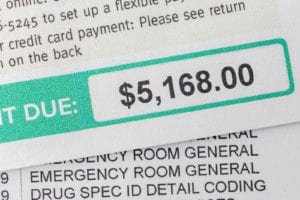Learn about common types of slip and fall hip injuries. Find out what your claim might be worth and what you need to win your case.
Slip and fall accidents are a leading cause of hip injuries in the United States. The violent impact from slipping and landing on your hip can cause damage to any part of the hip to victims of any age.

The hip joint is made up of:
- Bones
- Joints
- Ligaments
- Muscles and tendons
- Nerves and blood vessels
As we age, the risk of a serious fall-related hip injury increases. More than 95% of all hip fractures are caused by falling, usually falling sideways.
1. Hip Strains and Sprains
Hip strains or sprains happen when a muscle or tendon in the hip area is over-stretched or torn.
Minor sprains and strains can be treated at home by following your doctor’s instructions for rest, icing, and elevation. Over-the-counter medications may be recommended to reduce pain and inflammation.
Common symptoms of hip strain or sprain:
- Pain over the hip area
- Swelling
- Tenderness
- Bruising
Less common symptoms include sharp pain or tenderness in the lower leg.
Treatment for more serious tears may include:
- Physical therapy, strengthening exercises and massage
- Injections into the affected area
- Surgical repair
Settlement Value of Hip Sprains
Compensation for relatively minor sprains and strains will be under $5,000. This should cover your initial medical costs for the emergency room or urgent care, a few days of missed work, and a nominal amount for pain and suffering.
2. Traumatic Hip Bursitis
Bursae are small jelly-filled sacs that cushion the space between major joints and surrounding tissues. Traumatic hip bursitis is inflammation of a bursa cushioning the hip joint caused by a hard blow, often from a slip and fall accident.
Surgical treatment is rarely indicated for hip bursitis.
Non-surgical treatment options include:
- Reducing activities that hurt
- Non-steroid anti-inflammatory medications
- Using a cane or walker
- Physical therapy
- Injections of steroids and pain medication into the affected area
Estimated Compensation for Hip Bursitis
Compensation for hip bursitis can range from a few hundred dollars up to $10,000 depending on the recovery time, physical therapy expenses, and time lost from work.
3. Labral Cartilage Tears
The labrum is a ring of cartilage that helps keep the hip ball-and-socket joint together. Trauma from sports activity or slip and fall accidents can create a labral tear.
A labral tear may cause pain, difficulty walking, and a feeling like the hip joint is “clicking” or locking up.
Labral tears from falls usually occur in the back side of the hip joint. The victim may experience pain that radiates into the groin, hip, or buttocks while walking, or at night while trying to sleep.
Treatment for labral tears includes:
- Rest and activity modifications
- Over-the-counter pain medications
- Injections into the hip joint to manage pain and inflammation
- Physical therapy
Average Settlement for Hip Labral Tears
Compensation for hip labral tear injuries can range from $15,000 to $30,000 if surgical repair of the labral tear is required. A fair settlement will include the cost of surgery, out-of-pocket expenses, and lost wages, plus 2 or three times your economic damages to account for your pain and suffering.
4. Full or Partial Dislocations
Hip joint dislocations occur when the ball joint of the hip pops out of the socket. Hip dislocations are extremely painful and require immediate treatment to prevent permanent injuries. Hip dislocations can be partial or complete dislocations. In any case, a dislocated hip is a medical emergency.
Only a severe trauma, like a hard fall or car accident, can dislocate an adult hip joint. Hip dislocations may cause nerve damage, blood flow disruption to the leg bones, and eventually, arthritis in the affected hip.
Symptoms of hip dislocation include:
- Acute pain and muscle spams
- Leg turned out or in
- Visible distortion of the hip
- Swelling and bruising of the hip
- Inability to bear weight or move the leg
- Numbness in the affected leg or foot
Most patients are on crutches for two or three weeks, and fully healed within three months.
Settlement Payouts for Hip Dislocation
The average cost of non-surgical treatment for a hip dislocation runs just over $1,000. Assuming two or three weeks of lost wages, total compensation for economic and non-economic damages could range from $5,000 to $10,000.
5. Hip Fractures
Hip fractures most commonly happen when the fall victim lands on their side. This results in a fracture of the femur bone near the ball-and-socket joint.
The femur (also called the thigh bone) is the longest and strongest bone in the body. The head of the femur bone is the “ball” that fits into the hip socket. It takes a strong impact to break the femur.
There are two common types of femur fractures:
- A femoral neck fracture, where the femur breaks 1 to 2 inches from the hip joint.
- An intertrochanteric fracture, where the femur breaks 3 to 4 inches away from the joint.
Symptoms of a hip fracture are usually apparent immediately after the victim has fallen.
Broken hip symptoms include:
- Severe pain in the hip or groin
- Inability to get up or bear weight on the affected leg
- The affected leg may appear shorter than the other
- The foot of the affected leg may be turned out at an odd angle
Call 911 to ask for an ambulance if a hip fracture is suspected. Try not to move the victim, but keep them quiet and warm until the ambulance arrives.

Hip fractures from slip and falls usually require surgery, and may include a full hip joint replacement.
Hip surgery is serious, painful, and can take two to four weeks to recover, depending on your age and general health before the injury.
Rehabilitation after a hip replacement surgery may require inpatient services at a rehab facility or nursing home for several weeks.
Hip Fracture Injury Compensation
Hospital charges for the most common type of hip fracture surgery run as high as $66,000, with surgeons’ fees around $4,000. If the injury victim requires weeks of rehabilitation in a facility, averaging $225 per day, then medical costs alone can quickly add up to $75,000 or $80,000. Even when the injury victim isn’t claiming lost wages, a fair settlement amount may range from $200,000 to $400,000.
Proving Your Slip and Fall Hip Injury Claim

When your slip and fall injuries are caused by someone else’s negligence, you may be able to recover the cost of hip surgery, rehab, out-of-pocket expenses, and non-economic damages, like pain and suffering.
As with any other serious injury claim, you need medical bills and other evidence of your medical treatment.
Keep an updated list of all the medical providers and services you or your loved one required after the slip and fall. Keep copies of all reports and test results, hospital discharge summaries, and all other medical records and bills.
You should be compensated for the full cost of all reasonable diagnostic tests and treatments.
You might be treated by more than one type of doctor, like your family doctor, an orthopedic surgeon, a rheumatologist, and a physical therapist.
Diagnostic studies may include:
- X-rays
- CT scan
- MRI
If you have a pre-existing hip condition like osteoporosis or an old injury, you’ll need to show that the slip and fall directly cause your current pain and limitations.
Your medical records should also include your doctors’ opinions about your treatment and the likelihood of regaining the ability to walk and perform activities of daily living.
Non-economic damages, like pain and suffering, also need evidence. This will likely come from family members who knew you before and after the accident, and who can testify about the effects it’s had on your life. Your own testimony, as well as family photos and journal entries, can also be helpful.
Gather evidence of your work attendance and performance. Because most jobs require mobility, your hip injury will likely have caused you to miss significant work and may even prevent you from working in the future.
Keep track of your expenses and the ways that the injury affected your life. Also pay attention to how the injury has affected the lives of your family.
If you or a loved one has suffered a slip and fall hip injury, first take all the necessary steps to protect your or your loved one’s health, including appropriate medical attention. Then, contact a qualified personal injury attorney in your state for a free consultation and case evaluation.
How Much is Your Injury Claim Worth?
Find out now with a FREE case review from an attorney…